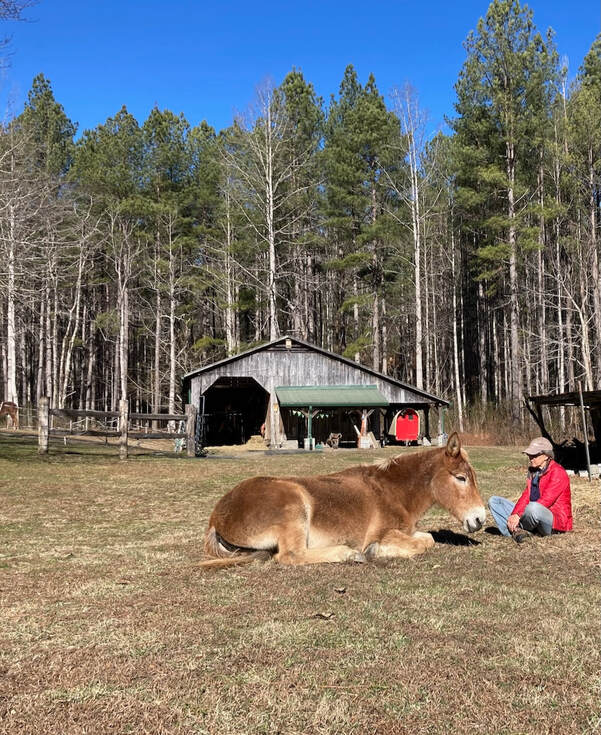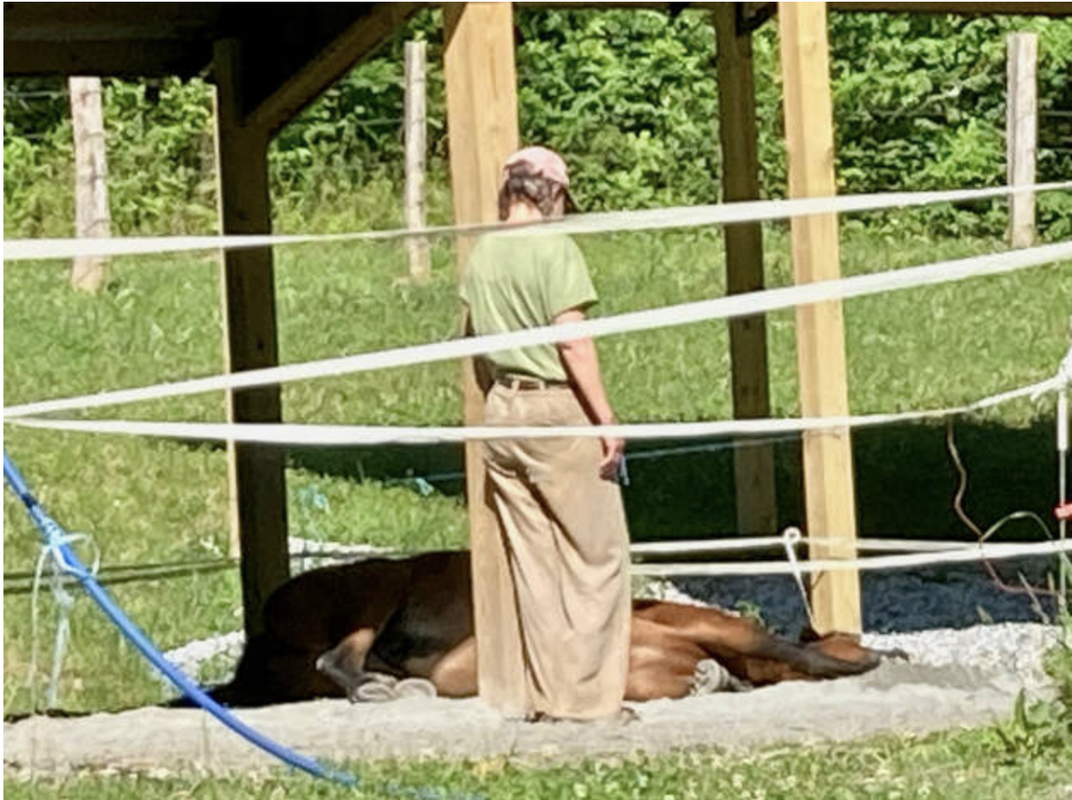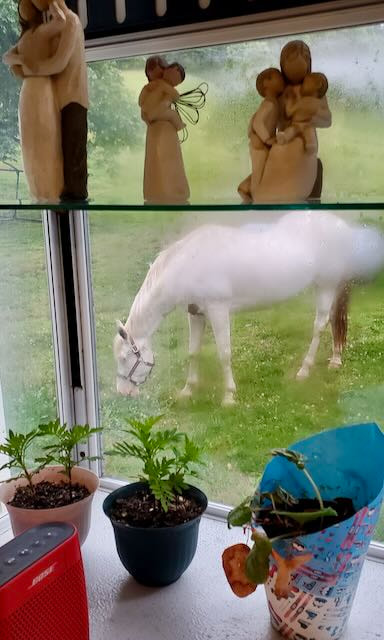The Trust Technique
“I highly recommend Julia. She taught us how to use the Trust Technique to get amazing results.”
Joy Baker DVM – FEI gold medalist and
founder of REIN horse rescue
Are you interested in deepening your connection with your horse or dog?
Do you wish your dog or horse could be more confident?
Does your horse or dog have a fear or anxiety that you wish they didn’t?
Do you wish you could understand what’s going on with your animal friend better?
Do you wish your dog or horse could be more calm?
Do you have an animal in physical pain? The Trust Technique can help lessen their pain.
Would you simply like to know more about an excellent tool for building connection, trust and confidence with animals you live and work with?
Joy Baker DVM – FEI gold medalist and
founder of REIN horse rescue
Are you interested in deepening your connection with your horse or dog?
Do you wish your dog or horse could be more confident?
Does your horse or dog have a fear or anxiety that you wish they didn’t?
Do you wish you could understand what’s going on with your animal friend better?
Do you wish your dog or horse could be more calm?
Do you have an animal in physical pain? The Trust Technique can help lessen their pain.
Would you simply like to know more about an excellent tool for building connection, trust and confidence with animals you live and work with?
The Trust Technique is a method for people and their animals to be mindful together. It is a gentle and extremely effective way to work with animals to overcome their fears and anxieties. It can help an animal’s well-being both physically and mentally. It is also a great way to teach them new things easily by reducing their thinking levels enough to put them in a curious and learning mind frame. We call this Realization Learning. The Trust Technique is also a beautiful way to work with an animal in a way that encourages partnership through Trusted Cooperation. They then do willingly because they want to.
My name is Julia Carpenter and I am a practitioner of the Trust Technique. I have been working with, caring for and training animals on and off my whole life. I am extremely interested in animal behavior and have been for many years. The Trust Technique is the simplest, kindest and most beautiful method I’ve ever seen to help animals learn and over come problems.
If you’d like to start working with the Trust Technique with your equine or would like to find out more,
please email me at [email protected]
I offer a 15 min call session for free where we can discuss your animal’s particular issue or problem and I can explain to you how the Trust Technique can help.
The first Trust Technique sessions is 1.5 hours long and cost $100.00
Follow up appointments are $75.00 for 1 hour
I service in person Western North Carolina some of Virginia and South Carolina. I also will occasionally book appointments in Massachusetts.
I can also work online via Zoom anywhere you are.
Coming soon I will be doing appointments for dogs too. I am finishing up my certification with them now. If you live near Lenoir, NC and would like me to work with your dog for free as a student practitioner, please send me an email, [email protected].
My name is Julia Carpenter and I am a practitioner of the Trust Technique. I have been working with, caring for and training animals on and off my whole life. I am extremely interested in animal behavior and have been for many years. The Trust Technique is the simplest, kindest and most beautiful method I’ve ever seen to help animals learn and over come problems.
If you’d like to start working with the Trust Technique with your equine or would like to find out more,
please email me at [email protected]
I offer a 15 min call session for free where we can discuss your animal’s particular issue or problem and I can explain to you how the Trust Technique can help.
The first Trust Technique sessions is 1.5 hours long and cost $100.00
Follow up appointments are $75.00 for 1 hour
I service in person Western North Carolina some of Virginia and South Carolina. I also will occasionally book appointments in Massachusetts.
I can also work online via Zoom anywhere you are.
Coming soon I will be doing appointments for dogs too. I am finishing up my certification with them now. If you live near Lenoir, NC and would like me to work with your dog for free as a student practitioner, please send me an email, [email protected].
More About The Trust Technique
The Trust Technique is a method of reducing thinking levels to promote connection, trust and confidence between an animal and their care giver. It is based on the knowledge that humans and animals share feelings, so what we are thinking or not thinking influences what they are thinking.
If a person is present and shares this feeling with an animal at the animals pace, the animal will get calm and sleepy.
The Trust Technique teaches people how to be mindful. It teaches them how to enter the present moment and then how to deliver this feeling to their animal at the animal’s pace.
The Trust Technique can be used to help an animal self-heal by leading them into a calm or even dream-like meditative mind frame where they can let go of tension, stress, anxieties and worries. The Trust Technique can help an animal overcome their fears, anxieties and behavioral issues. The Trust Technique, also can help an animal learn new things by reducing their thinking levels to a point at which it is conducive for them to learn.
The Trust Technique deepens the connection between the owner and the animal, because the owner, using the Trust Technique, can help their animal overcome fears and anxieties. This promotes a feeling of trust and confidence between them.
There are 3 main levels to the Trust Technique. The first is Creative Reaction. Creative Reaction is the way we get in a present mind frame, and then how we deliver this to an animal at the animal’s own pace, using Mindful Regard.
The second level is called Realization Learning. This is where we reduce the animal’s thinking with Creative Reaction and Mindful Regard to the point at which it is easy and conducive for an animal to learn new things and to self-realize that old patterns of fear and anxiety are not real. A calm mind allows an animal to gain new perspectives and to shed old patterns of thinking.
The third level of the Trust Technique is called Trusted Cooperation. Trusted Cooperation is a way of working with an animal based on mutual benefit. It is non-dominate and not based on competition, where the person is the boss and the animal is the subordinate. Rather, this method is based on mutual trust and cooperation. It relies on the fact that animals are highly intelligent and can be motivated to do almost anything so long as they can do it, the task is clear to them, and the pay is fair. This is nothing we would not expect from business with another human.
To learn more about the Trust Technique and its founders, James French and Shelly Slingo, please follow the link below. Here, you can also watch the free Messages of Trust video course, which will give you more of a detailed understanding of the Trust Technique. If you are more interested in using this technique with your animals you can purchase The Trust Technique Video Course here as well.
https://trust-technique.com/product/messages-of-trust/tt/316/
Blog Posts About The Trust Technique
Podcasts
Today's Horsewoman episode 115: Julia Carpenter, horsewoman
Our old mule Polly was standing in the sun in front of the shed on the right. I sat down at the base of the tree in the photo and started to do the Trust Technique with her. She walked over and laid down next to the hay pile. I followed her over and kept doing the TT. She finally let go of her tension from the windy weather and fell asleep.
The above video is of an old horse named Mr. Jones, who I have worked with during my training. Mr. Jones was being bothered by his sore shoulders, his sunburned eyes, and the flies. They were awful that day. I started offering him the present moment. After about 5 minuets he lowered his head and fell asleep. He got very quiet and even stopped twitching his skin and stomping.
I thought maybe the flies had left, but when I looked at him they were still crawling all over him, he just stopped thinking about what was bothering him so much, and slid into the present moment with me. It was amazing to witness how the Trust Technique could bring him some peace.
My friend who is a vet and owns Mr. Jones called me later to ask if I'd had a break through with him, as he was acting very unusual for himself and being more social. She sent a picture of him to me of him hanging out in front of her kitchen window. He'd apparently followed her all around as she weeded the garden, and then when she went in the house, he stayed out front waiting for her to come back out.
* This story and video used with the permission of Mr. Jones' owner.
About Me
Julia Carpenter is the first certified equine practitioner of the Trust Technique on the East Coast. She grew up on a horse farm in Vermont and has been a licensed riding instructor and trainer working with racehorses, hunter jumpers, polo ponies and field hunters.
Julia has had a lifelong friendship and association, researching, training and caring for animals. She is interested in helping animals, particularly horses, heal from trauma and loves volunteering to help out animal rescues with the Trust Technique. She has a private practice helping people and their equines learn and benefit from the Trust Technique.
Julia has degrees in wildlife management and environmental policy from Boston University and Tufts and has worked in the wildlife and environmental fields. She is a painter, and her animal paintings have been shown in galleries and shops in the Boston area and western NC. She is the author of one little cookbook called Pet Food: 16 Dessert Recipes to Make You Smile.
Julia lives on a small farm in the mountains of western North Carolina with her husband Bernie Harberts, the Longrider, filmmaker, and author, in addition to two rescue border collies, three mules, a rescue pony and her halflinger. She enjoys riding in the mountains around her farm and on longer rides with Bernie. She blogs about her life with the animals, equine rambling and the Trust Technique at www.consideringanimals.com.
Julia has had a lifelong friendship and association, researching, training and caring for animals. She is interested in helping animals, particularly horses, heal from trauma and loves volunteering to help out animal rescues with the Trust Technique. She has a private practice helping people and their equines learn and benefit from the Trust Technique.
Julia has degrees in wildlife management and environmental policy from Boston University and Tufts and has worked in the wildlife and environmental fields. She is a painter, and her animal paintings have been shown in galleries and shops in the Boston area and western NC. She is the author of one little cookbook called Pet Food: 16 Dessert Recipes to Make You Smile.
Julia lives on a small farm in the mountains of western North Carolina with her husband Bernie Harberts, the Longrider, filmmaker, and author, in addition to two rescue border collies, three mules, a rescue pony and her halflinger. She enjoys riding in the mountains around her farm and on longer rides with Bernie. She blogs about her life with the animals, equine rambling and the Trust Technique at www.consideringanimals.com.
Up Coming Events
Sold out!






